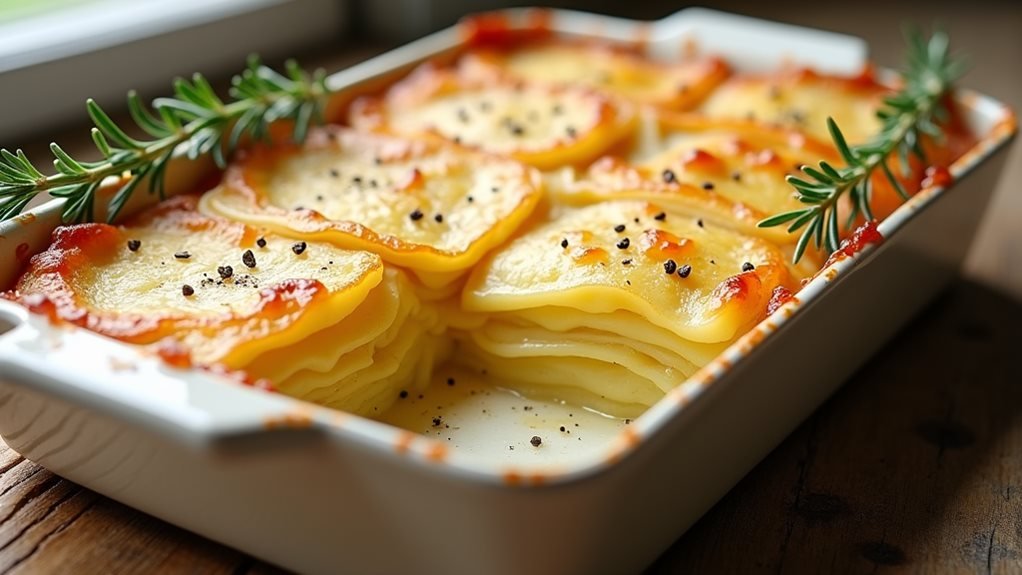Creating Gordon Ramsay’s Classic French Croissant at home. This guide will detail how to make classic French croissants with a flaky and golden exterior that promises a delightful, rich, and buttery experience with each bite. The quality of butter is non-negotiable when achieving that unparalleled buttery flavor and perfect croissant texture.
European butter, known for its higher fat content, is preferred for its flexibility, which is which is essential in the laminated dough method. For those unable to access European-style butter, blending it with a little flour can help increase its flexibility.

French Croissant Recipe
Ingredients
For Croissant Dough
- 4 ¼ tsp. fresh, dry instant yeast (check expiration date)
- 3/4 Cup cup cold water
- 4 ¼ cups all-purpose bread flour, more for dusting and cutting board
- 2 tbsp. European or Vermont-style butter (83-84% butterfat content), unsalted, softened
- 1/3 cup granulated sugar
- 1 large whole egg
- 1 tbsp. heavy cream
- 2 ⅛ tsp. kosher salt
For Making Butter Slab
- 2 ½ sticks European or Vermont Style Butter (83-84% butterfat content)
For Egg Wash
- Two whole eggs
- 1 small pinch of salt
- A splash of milk
Instructions
Making the Dough
- Activate the Yeast: In a small bowl, dissolve the yeast in cold water and let it sit for about 5 minutes until it becomes frothy.
- Mix Dry Ingredients: Mix the bread flour and granulated sugar in a large bowl.
- Add Wet Ingredients: Add the softened butter, yeast mixture, large whole egg, and heavy cream to the flour mixture.
- Knead the Dough: Combine the ingredients until a dough forms. Add the kosher salt and knead until the dough is smooth and elastic. This process might take about 10 minutes by hand or 5 minutes in a stand mixer with a dough hook.
- First Rise: Cover the dough with plastic wrap and let it rise at room temperature for 1 to 2 hours or until it doubles in size.
Preparing Butter Slab
- Soften the Butter: Let it soften at room temperature, but it should still be cool.
- Form a Slab: Between two sheets of parchment paper, roll the butter into a rectangle that’s about 8×5 inches.
- Chill the Butter: Place the butter slab in the fridge until it is consistent with the dough.
Laminating the Dough
- Roll Out the Dough: Roll the dough into a rectangle about 16×10 inches on a floured surface.
- Encase the Butter: Place the butter slab on half of the dough, then fold the other half over it.
- First Fold: Roll out the dough to a 16×10 inch rectangle again. Fold the dough in thirds like a letter.
- Chill: Wrap the dough in plastic and chill for 1 hour.
- Repeat: Complete two more folds, chilling the dough for 1 hour between each fold.
Shaping the Croissants
- Roll the Dough: Roll the laminated dough to about 1/4 inch thickness.
- Cut Triangles: Cut the dough into long triangles.
- Shape Croissants: Roll each triangle from the base to the tip, forming a croissant shape.
- Second Rise: Cover the croissants on a baking sheet and rise for 1 to 2 hours.
Baking
- Preheat the Oven: Heat your oven to 375°F (190°C).
- Egg Wash: Beat two whole eggs with a pinch of salt and a splash of milk. Brush this mixture over the croissants.
- Bake: Bake the croissants for about 15 minutes or until golden brown.
Serving
- Serve the croissants warm, fresh out of the oven, or at room temperature.
Video
Notes
The Secret to a Good Croissant
The secret to a good croissant lies in the quality of the ingredients, the lamination process, and precise technique. High-quality butter with a high-fat content is crucial for flavor and for creating distinct, flaky layers. The dough must be carefully mixed, fermented, and laminated to create numerous thin layers separated by butter. Temperature control is also essential to prevent the butter from melting into the dough, hindering layer formation.
Best Flour for French Croissants
The best flour for making French croissants is high-quality, high-protein bread flour. Look for flour with a protein content of around 11.5% to 13%. This gives the dough the necessary strength and elasticity for the layers and flakiness that croissants are famous for. In France, the preferred flour type is often labeled as “Type 55, “a white flour that is relatively low in ash and has the right protein content for croissant dough.
What the French Put on Croissants
In France, croissants are often enjoyed plain, especially fresh and high-quality. However, some common toppings and fillings include:
- Jams and preserves, such as apricot, strawberry, or raspberry
- Honey or Nutella
- Almond paste for almond croissants
- Ham and cheese for savory croissants
- Butter and chocolate spread for a decadent treat
What Makes French Croissant Different
French croissants are renowned for their quality and tradition. The difference often lies in the adherence to traditional methods and the use of high-quality, locally sourced ingredients. French bakers might also use a specific type of low-protein flour and a particular butter with a higher melting point, contributing to the croissant’s distinct flavor and texture. The technique and experience of French bakers, honed over generations, also play a significant role in the uniqueness of French croissants.
How Many Layers Does a Traditional French Croissant Have?
A traditional French croissant features 55 layers, including 27 butter layers, created through a French fold and then three letter folds. If you use fewer layers, the texture changes; it becomes less tender and chewy, with more pronounced layers. However, creating too many layers can cause the butter to spread too thin and melt into the dough.
Summing Up
In truth, the magic wrought by kneading butter into the yielding dough is a form of alchemy that transforms simple ingredients into layered realms of flavor and texture. Gordon Ramsay’s French Croissants mastery here does not come quickly; it demands attention, patience, and a reverence for the craft. Surely, cutting into a homemade croissant, its golden flakiness yielding to the pressure of the knife, evokes a pride in creation, a deep satisfaction found in the ritual of baking.
Each buttery layer whispers tales of tradition, technique, and the quiet joy of a morning indulgence—defiance against a world that is often rushed and flavorless. It’s an eloquent reminder that sometimes, the most worthy feats oblige us to slow down and savor the moment and the fruits of our laborious yet loving endeavors.








